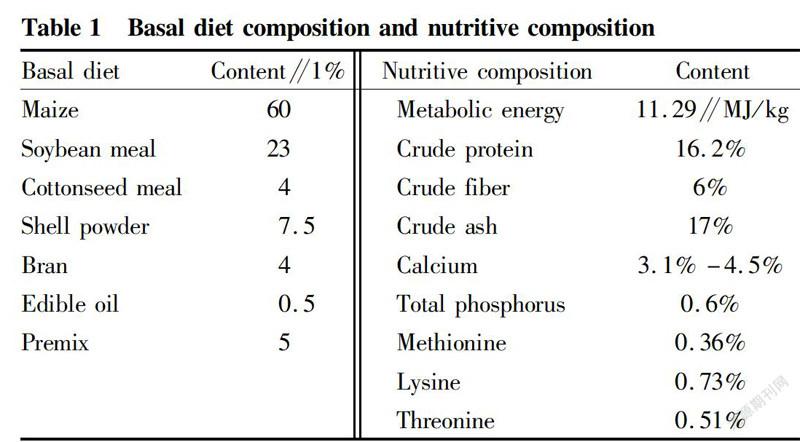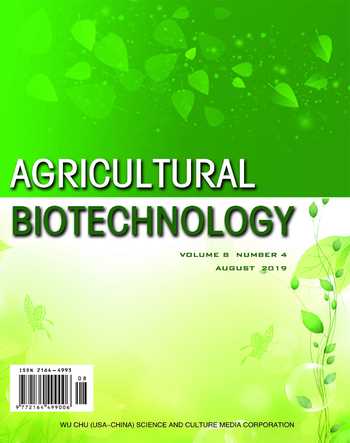Correlation Between Cholesterol Content in Egg Yolks and Laying Rate
2019-09-10JiaoLIYuanqingZHONGYihaoZHANGJintangLUODongxuWANGYiqiZHANGSuohuaZHAO
Jiao LI Yuanqing ZHONG Yihao ZHANG Jintang LUO Dongxu WANG Yiqi ZHANG Suohua ZHAO

[Methods] Forty eight 450dayold Hyline brown hens with uniform weight were randomly divided into 4 groups with 3 replicates in each group and 4 individuals in each replicate. Group 1 as the control check group (CK) was fed the basal diet; group 2 was fed the basal diet with the addition of 150 g/t of probiotics; group 3 was the basal diet +200 g/t lipase group; and group 4 was fed the basal diet with the addition of 150 g/t of probiotics and 200 g/t of lipase. The preliminary trial period was 10 d, and the experimental period was 30 d.
[Results] The cholesterol content in the egg yolks of each test group was higher than that of the control group at 14 and 28 d after the drug administration. The laying rate of each test group began to increase at 14 d after the drug administration; and the laying rate of each test group increased significantly 28 d after the drug administration. It indicated that with the increase of cholesterol in egg yolks, the laying rate of laying hens increased significantly.
[Conclusions] This study provides a certain experimental basis for culture production of laying hens.
The cholesterol in laying hens is almost entirely selfsynthesized. Studies have shown that laying hens synthesize about 300 mg of cholesterol per day, about twothirds of which are deposited in the eggs, and almost all of the cholesterol in eggs is concentrated in yolks. Many scholars have conducted studies on reducing the content of cholesterol in yolks, but as the cholesterol content of egg yolks decreases, the production performance of laying hens also changes. Furthermore, the results were quite different. Ankari et al.[1]found that when Cu2+caused a linear decrease in cholesterol in egg yolks, egg production and feed conversion ratio were also severely reduced. Liu et al.[2]found that lovastatin can reduce the yolk cholesterol concentration (as low as 8%) and promote the laying rate. Chen and Zhang et al.[3]found that the reduction of cholesterol may affect the normal function of the ovary and the laying rate. Yang et al.[4]added selenium yeast to the feed of laying hens and found that the cholesterol content in egg yolks was decreasing and the laying rate was significantly improved. Li[5]found that the addition of saponins to the feed of 180dayold Hyline brown hens can significantly reduce the cholesterol content of egg yolks, but the laying rate tended to increase. Wei et al.[6]found that adding green tea powder to the feed of laying hens can significantly reduce the cholesterol content in egg yolks, and the egg production rate has a significant downtrend. In this study, such two indexes as cholesterol and laying rate in egg yolks were investigated, so as to further understand the relationship between the two indexes. This study will provide a certain experimental basis for culture production of laying hens.
Materials and Methods
Experimental animals and additives
The test animals were 450dayold Hyline brown hens, purchased from a laying hen farm in Tianjin. The probiotics (the main ingredient was Bacillus) and enzyme preparation (mainly composed of lipase and bile acid) were donated by Kunming Baijia Yikang Biotechnology Co., Ltd..
Main instruments and reagents
LD52A centrifuge, Liaoning Saiyasi Science and Technology Co., Ltd.; thermo and DRAGON pipette; UA6100 UV spectrophotometer, Shanghai Meipuda; biochemical incubator, Jinan Hui Xie Medical Equipment Co., Ltd.; cholesterol kit, purchased from Nanjing Jiancheng Bioengineering Institute.
Basal diet composition and nutritional level
The basal diet was prepared according to the Chinese Feeding Standard (2004) of Poultry. The basal diet composition and nutritional level are shown in Table 1.
Experimental design
Forty eight 450dayold Hyline brown hens with uniform weight were randomly divided into 4 groups with 3 replicates in each group and 4 individuals in each replicate. Group 1 as the control check group (CK) was fed the basal diet; group 2 was fed the basal diet with the addition of 150 g/t of probiotics; group 3 was the basal diet +200 g/t lipase group; and group 4 was fed the basal diet with the addition of 150 g/t of probiotics and 200 g/t of lipase. The preliminary trial period was 10 d, and the experimental period was 30 d.
Feeding and management
The feeding experiment was carried out in the experimental farm. The chicken house was built in three layers, and the hens were raised with manual feeding, free drinking, manual feces removal and manual egg picking. The numbers of eggs and broken eggs were recorded every day.
Inspection items and methods
Determination of cholesterol in yolks
On the 14thand the 28thd of treatment, 6 eggs laid on the very day were broken and poured into a 9 cm clean petri dish, respectively. Each egg was extracted with a syringe for 1 ml of egg yolk, which was added into a clean test tube. Then, 9 ml of anhydrous ethanol was added, followed by stirring and mixing. Each mixture was centrifuged at 2 500r/min for 10 min. The supernatant was extracted and measured with a kit and an ultraviolet spectrophotometer for the content of cholesterol in the egg yolks.
Statistics of laying rate during the experiment
The eggs laid by the laying hens in each group before the drug administration, from the day of drug administration to14 d after the administration, and from 14 d after the administration to 28 d after the administration of drug were summed, respectively, followed by the calculation of the laying rate.
Data processing
The data were processed with Excel 2007, and the results of cholesterol determined were analyzed using spss 17.0 software.
Results and Analysis
Determination and analysis of cholesterol in egg yolks
The determination results are shown in Table 2. It can be seen from Table 2 that the cholesterol content increased on the 14thday of treatment in the egg yolks of the test groups, and the cholesterol contents in the egg yolks of groups 2 and 3 were significantly different from the control group (P<0.05). On the 28thd after the drug administration, cholesterol in the egg yolks was still higher than that in the control group, and test group 3 was significantly higher than the control group (P<0.05). It showed that the addition of the probiotics and enzyme preparation in the feed improved the cholesterol content in egg yolks.
Change in laying rate during the experiment
The change in laying rate of each group during the experimental period is shown in Table 3. It can be seen from Table 3 that the laying rate of the control group decreased slightly during the whole experimental period, and the laying rates of test groups 2, 3, and 4 began to increase at 14 d after the administration; and at 28 d after the drug administration, the laying rate was significantly higher in the test groups than the control group. The results showed that the laying rate of the laying hens in the late stage of egg production significantly increased in the groups with the addition of the probiotics and enzyme preparation in the feed, which is consistent with the research results of Liu et al.[7].
Discussion and Conclusions
After adding the probiotics and enzyme preparation to the feed, the cholesterol content in egg yolks increased, and the laying rate of laying hens increased significantly, indicating that there is a certain correlation between cholesterol content in egg yolks and egg production rate[8], and the content of cholesterol in egg yolks is not the lower the better. The laying rate of laying hens can only be improved when the cholesterol in egg yolks reaches a certain level[9], but the optimal content of cholesterol in egg yolks affecting the laying rate of laying hens still needs further study.
References
[1] ANKRI AA, NAJIB H, HOZAB AA. Yolk and serum cholesterol and production traits, as affacted by incorporationg a supraoptimal amount of copper in the dietoy the leghorn hen[J]. British Poulery Sci., 1998, 39: 393-397.
[2] LIU LT. Studies on the effects of different additives on egg cholesterol and its application[D]. Wuxi: Jiangnan University, 2001. (in Chinese)
[3] CHEN DM, ZHANG KY. Cholesterol deposition mechanism in laying hens[J]. Chinese Journal of Animal Nutrition 2003.15(4): 1-6. (in Chinese)
[4] YANG Y, SUN Y, SUN BS, et al. Effects of selenium yeast supplementation on performance, egg quality, antioxidant and lipid metabolism and their related gene expression of laying hens at late laying period[J]. Chinese Journal of Animal Nutrition, 2018, 30(11): 4397-4407. (in Chinese)
[5] LI DD. Effects of saponins on production performance, egg quality and expression of cholesterol metabolismrelated genes in laying hens[D]. Zhengzhou: Henan Agricultural University, 2017. (in Chinese)
[6] WEI YH, QU XY, CAI C, et al. Effects of feeding green tea powder on laying performance, egg quality and egg yolk cholesterol content in laying hens[J]. China Feed, 2012, 22:22-24. (in Chinese)
[7] LIU BX, BI YB, SONG YF, et al. Effects of compound microecological preparation on production performance and egg quality of laying hens during laying period[J].Heilongjiang Animal Science and Veterinary Medicine, 2017, (04): 62-64. (in Chinese)
[8] BRAGAGNOLO N RODRIGUEGAMAYA DB. Comparison of the cholesterol content of Brazilian chicken and quail eggs[J]. J Food Comp Anal, 2003, 16: 147-156.
[9] DU XH, XIONG T, LIU JY, et al. Relationship between serum/yolk cholesterol content and egg traits in hens of 300 days age[J]. China Poultry, 2013, 35(11): 11-14. (in Chinese)
Editor: Yingzhi GUANG Proofreader: Xinxiu ZHU
杂志排行
农业生物技术(英文版)的其它文章
- Copyright Authorization Statement
- Optimization of Enzymatic Extraction of Sodium Chondroitin Sulfate From Bovine Nasal Bone
- Quality Analysis of Lycium ruthenicum Murr. from Different Producing Areas
- Optimization of Extraction Process of Anthocyanins from Selenium-enriched Purple Potato by Response Surface Methodology
- Research on Extraction and Purification Technology of Flavonoids from Quinoa (Cheuopodium quinoa) Le
- Effect of Different Processing Techniques on the Content of Total Alkaloids in Toddalia asiatica Lam.
